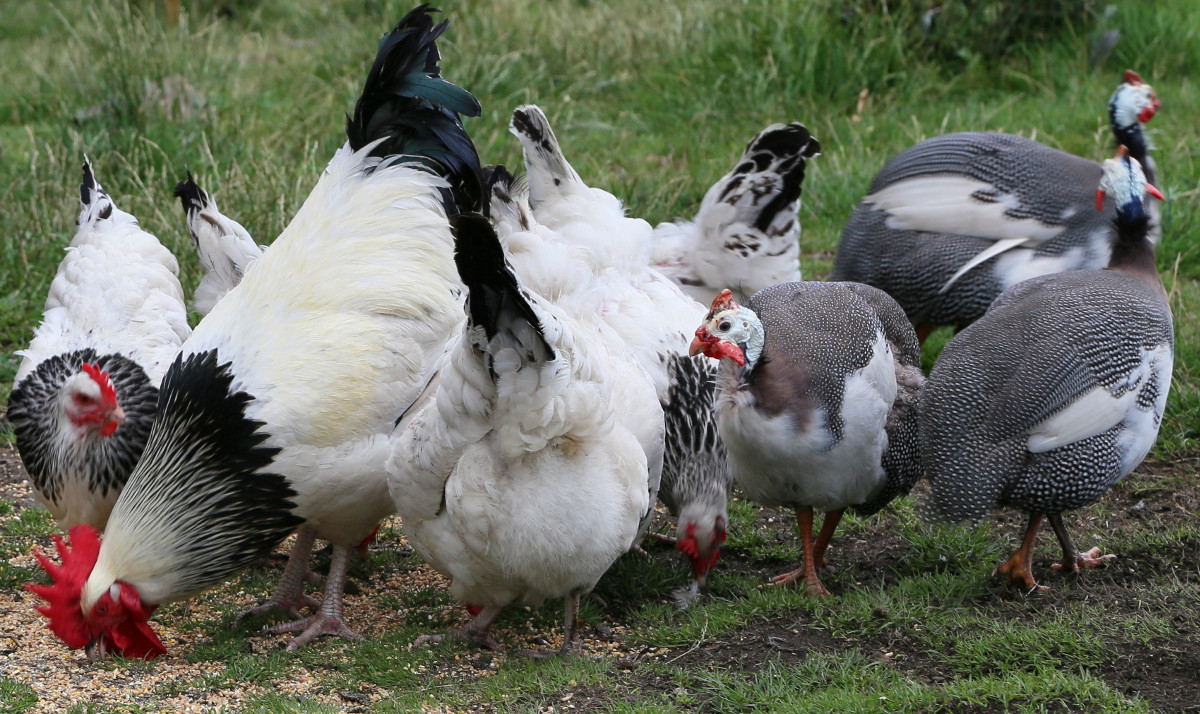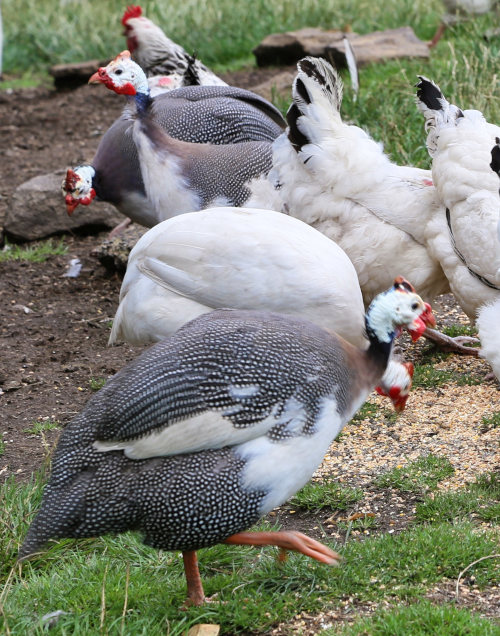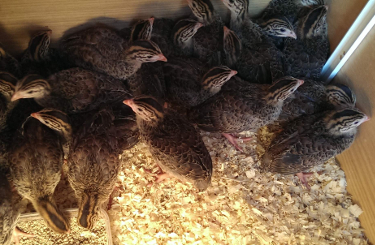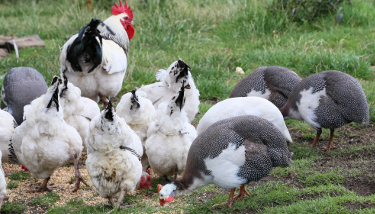Feeding Guinea fowl.

Table of Contents
- What do you feed Guinea fowl?
- Can Guinea fowl eat chicken food?
- When do you feed Guinea fowl?
- How much do Guinea fowl eat?
- Feeding keets and baby Guineas:
- What do Guinea fowl eat in the wild?
- Guinea fowl nutritional needs:
- Guinea fowl food preferences:
- Feeding growing keets:
- Keeping Guinea fowl entertained:
- What not to feed Guinea fowl:
- What additives and supplements do Guinea fowl need?
What do you feed Guinea fowl?
Guinea food invariably has to be home mixed as there is currently no specific commercially available feed for Guinea fowl. I feed my Guinea fowl a home made mix of duck and goose pellets and scratch grains with added seeds as well as whatever they can find while they free range.
My birds have an all mixed pellet, grain and seed scratch that includes 4% sunflowers seeds 4% safflower seed, wheat, cracked maize and millet. My mix also has 2% each of shell and grit.
Can Guinea fowl eat chicken food?
Guinea fowl can eat exactly the same feed as the chickens get but they may ignore the layers pellets. It is not ideal to feed Guineas plain chicken feed as it is a little low in protein.
This will never be a problem if your Guinea fowl free range as any insects they find will make up the difference easily.
When do you feed Guinea fowl?
I feed my Guinea fowl first thing in the morning when they are first let out and then last thing before they roost in the evening. They graze all day but tend to have a big feed first thing in the morning and last thing before bed. I sometimes never see them all day.
My Guinea fowls are all free range and spend their day in 4 acres of North Yorkshire.
Below: My pied Guinea fowl live with my Light Sussex flock.

How much do Guinea fowl eat?
Guinea fowl eat between 100 and 150 grams or 4 and 6 ounces of food per day. Guineas will eat much more in winter when they need to keep warm and less in summer when there is an abundance of natural food about.
Feeding keets and baby Guineas:
Young Guinea fowl chicks or keets require much more protein, in the order of 24% to 28% in their first few weeks. You can give them either a game fowl ration or a turkey starter. Grated boiled egg works just fine as well as a protein boost.
Guineas need to consume some greens in order to maintain good digestion, and so they eat sprouts, grass, dandelions, weeds, and other vegetation. It is a wandering bird requiring an extensive range and it finds nearly all of its food, especially in the summer months when there is plenty of insect life about.
Guineas need the same grit with shell and fresh water all poultry does.
What do Guinea fowl eat in the wild?
Guinea Fowl are endemic to Africa, where they are extensively distributed.
Guineas get together in large flocks and frequent open glades, the borders of forests, and banks of rivers, which offer abundant supplies of seeds, grains, berries, and insects, in quest of which they wander during the day, and collect together at evening, and roost in clusters on the branches of trees or shrubs.
Adult Guineas forage for themselves with little tendency to laziness and are able to meet most of their nutrition requirements provided they have enough land to cover. They consume a variety of insects and arachnids, seeds, slugs, worms, small rodents and caterpillars.
They graze all day but tend to have a big feed first thing in the morning and last thing before bed. I sometimes never see them all day.
Guinea fowl nutritional needs:
Because the birds are consuming vegetation, it is important to make sure grit is available for the birds, and the birds also benefit from having oyster shell available.
Provide clean water at all times. Guineas do enjoy a scratch feed in a trough.
They like Barley, oats, wheat, sorghum, or millet grain and seem to ignore chicken pellets and whole corn kernels.
If you are keeping the guineas for pest control, restricting their feed during the day will encourage them to spend more time searching for insects and natural feed stuffs.
If for any reason Guinea fowl are not allowed to forage, they can be fed a commercial poultry diet for game fowl or turkeys.
Below: Guineas love to free range and grass on greens as well as hunt for bugs.

Guineas need a higher protein feed than chickens, but do quite well on regular poultry diets. Keets need at least 24% to 26% protein ration as the starter feed. The protein level should be reduced to 18% to 20% for the fifth to eighth weeks.
The use a medicated feed for keets. Unmedicated feed is a personal choice but I always feed medicated when young to prevent Coccidiosis.
After six weeks the keets can be fed a 20% grower feed with a little extra protein included.
If your supplier does not sell feeds in the proper protein levels you can mix a higher protein feed with chicken feed to get the proper protein level.
Plain pelleted only feed is not recommended for Guineas, you should mix other seeds and grains in.
You should also provide supplemental greens if your Guinea fowl are kept confined, such as hanging a cabbage or green leafy vegetables, for the Guineas to peck at. They will eat the leaves.
They should be fed regularly, and must always have one meal at night,
Guinea fowl food preferences:
Guineas raised without chickens should be fed a turkey or game bird feed. The high protein feed is necessary for fast growing keets should not to be confused with the amount of protein in a pre-mixed feed for adults.
One of the problems with this feed for adult laying birds is it lacks the ingredients to colour the egg yolks and birds feeding on nothing else with have pale washed out yolks.
Feeding Guinea fowl keets can be a bit daunting for the first timer as you can not buy a bag of Guinea fowl feed or keet feed like you can for other poultry.
What you are looking for and may need to ask for is turkey Starter or Game Bird Starter. Keets can survive on chick starter with added grated boiled egg but turkey starter is much better for them due to the higher protein content.
This is the pre-made starter feed I use for my keets. I use medicated turkey starter because it has an added coccidiostat to aid in the prevention of coccidiosis. The feed can't be used as a treatment only a preventative and keets raised on unmedicated feed might get this infectious, often fatal disease.
If your feed mill does not carry this feed, ask them what they recommend, and ask what is available to you. Some feed mills carry only unmedicated turkey starter.
Feeding growing keets:
Beginning at 6 to 8 weeks of age, wean keets off this starter feed onto a regular turkey grower by gradually mixing increasing amounts of grower feed into the starter until the bag is empty around 8 weeks of age.
The 18% protein supplied in this nutritionally complete mix is fine for adult guinea fowl. They get extra protein from bugs and insects when they are on range daily during laying season.
Below: Well grown keets, you can just see the crumb in the corner.

They should have plain grit with no added calcium available to them at all times. I feed mine sprouted grains from day 3. Soak a little millet in water and leave it to sprout by whatever method you use and feed a teaspoon or so per keet per day.
They love greens like dandelion leaves and fresh green shoots.
Keeping Guinea fowl entertained:
Being members of the game bird family over-crowded or bored chicks may be prone to feather-pecking and it is important to have plenty of containers so that there is no competition for feed or water.
Provide additional attractions to keep the bird occupied, such as green stuffs hung up for them to peck at.
A mirror will give both you and the Guinea fowl hours of endless fun.
Do not forget the dust bath.
What not to feed Guinea fowl:
In addition to a balanced diet and some ground to range over there are a few things you should avoid giving Guinea fowl.
Guinea fowl are generally much easier on your plants than chickens but you can not use pest sprays when you have guinea fowl as you may poison them.
They do so much wandering they will find all sorts. Never feed the following to Guinea fowl:
- Chocolate or caffeine - Both are fatal even in small quantities.
- Dried lentils or raw beans - Beans need to be heat treated or roasted. They contain a toxin called phytohaemagglutinin which is fatal to humans in surprisingly small quantities let along guinea fowl. Don't let them into a vegetable patch where beans are going. as few as 4 beans can kill. Once eaten, there's nothing to be done to save the bird.
- Rhubarb and Avocado - Avocado's contains persin that's poisonous to chicken and the things are way expensive so why bother. Rhubarb contains Oxalic acid which can make them feel really unwell for a long time and give them soft shelled eggs.
- Too many scraps - I once saw this summed up brilliantly in a poultry book from the 1860's. The author said " If you have a lot of scraps from the kitchen you probably need to look at how you are feeding your family" Bread is not good for poultry and feeding kitchen scraps to any livestock is illegal in most parts of the west.
- Green tomatoes or potatoes or uncooked potatoes - They are members of the deadly nightshade family.
- Guinea fowl should not eat any mushroom, mould or fungus. Some are poisonous and spores can germinate in the crop, stomach and intestines and release toxins that kill in very small amounts.
- Alcohol - Ethanol is poisonous to Guinea fowl. - See poultry and alcohol.
For a full list of what poultry can and can not eat take a look at this list.
What additives and supplements do Guinea fowl need?
The short answers is not that many and they do not need much either especially if they are free range.
All supplements are the same, they are best used over a long period in small quantities. you can do as much harm as good by overdosing.
There is two reasons for this, the first is they find a lot of their own feed and prefer it this way. The second reason is they are not prolific layers like modern chickens that require huge amounts of calorific feed to produce eggs daily.
Below: Guineas Feeding.

If you keep your Guinea fowl confined or if you live in a place where there is snow and ice on the ground in winter then you will need to add a few bits and pieces to the diet to keep them healthy.
Below are things you can consider as additional supplements to improve the diet of captive guinea fowl:
- Grit and shell: This is exactly the same mix you would give to chickens and the same size. It should be always available to Guinea fowl regardless of how you keep them. It is important for digestion to help grind up food and for minerals like calcium.
- Safflower seeds or sunflower seed kernels: These both have similar calorie and protein levels and are high in both. Guineas love whole seed scratch feed and these are a particular favourite of my birds. Safflower seeds have a white shell and do not need to be bought shelled. Sunflower seeds on the other hand should be bough husked or with the shell removed.
- Sprouts: You can sprout wheat, oats, barley, peas, millet, lentils or mung beans. Sprouted seeds and grains are actually more nutritious than either feeding them whole. You can feed as soon as they sprout or wait till they have produced a green shoot before feeding. The latter is especially beneficial in winter when natural greens may be in short supply.
- Seaweed: Seaweed is loaded with trace elements and minerals and is a source of salts which are required in the diet but might be lacking in winter with no insect life around for them to feed on. Dosage is 2g per bird per day. Just dampen the seed slightly and sprinkle over and the seaweed granules will stick to the seed.mix thoroughly.
- ACV or Apple cider vinegar: This is a well known additive for chickens and it may be of some benefit to guinea fowl as well for the same reasons.
- Powdered yeast extract: This is a dry and powdered by product of the brewing industry. It contains masses of B vitamins and 18 amino acids. It also has the benefit of being 55% protein. B vitamins are all involved in the metabolism of carbohydrates, fats and proteins into usable energy and some are also important for digestion, immunity and red blood cell production within bone marrow. Dosage: A little goes a long way and as with all supplements they are best added to foo and taken in small quantities over a long period. 2g per bird per day added to feed.
- Food grade DE or Diatomaceous Earth: Diatomaceous earth (DE) is a combination of silica, sodium, magnesium, iron and a mixture of other trace minerals. Dust the coop and nests or add 1 to 2 cups of DE per bag of feed for optimal health benefits: DE can improve the quality of eggs if you are having shell problems, keep the feed pest free, prevent internal and external parasites with regular use and make sure the birds have minerals available to prevent joint problems.
- Flower petals: Dandelions, Marigold or Sunflower petals. All contain natural colours than are known to be beneficial to the eyes and make bright yolks. These are best grown yourself as they can be expensive to buy. Dry petals in the sun as the flowers are ready and store for whenever you need. They can be bought.
- Grated boiled egg: For that protein boost when the birds are moulting. Moulting can be minimal or extensive and can happen gradually or fast. Feather loss can be extreme and added protein is the best solution. Feathers consist of about 85 percent protein, so big or fast moults can spell trouble.
